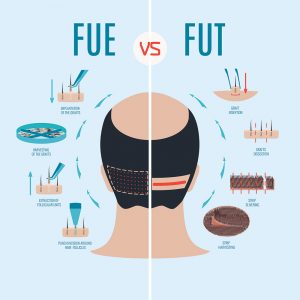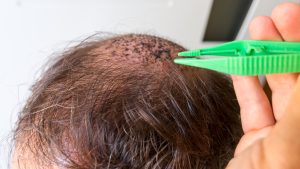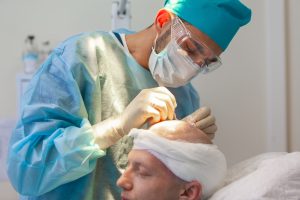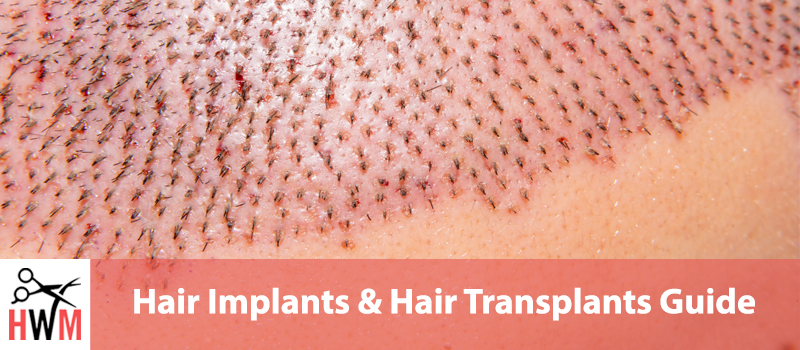Two types of people are interested in hair plugs and hair implants. These are individuals for whom things like better nutrition, an improved lifestyle, finasteride, and minoxidil didn’t work or individuals who don’t believe in stopgap measures and want the permanent solution straightaway.
Of course, it’s a given that you’re conscious about your appearance if you’re worried about hair loss. After all, why shouldn’t you be? Hair loss, even earlier stages of it such as a receding hairline, is insidious enough to affect a person’s self-confidence.
This fact is backed by science too. One study revealed how men view hair loss to be “an unwanted, distressing experience” that results in “considerable preoccupation, moderate stress or distress, and copious coping efforts”. Another 2005 study focusing on “the psychological impact of alopecia” on both men and women found it to be closely associated with “high levels of anxiety and depression”.
Therefore, although it only affects how you look, it is completely natural for you to worry about hair loss and consider getting hair plugs. In fact, it is extremely fortuitous that you’ve decided to learn more about hair plugs instead of going head or scalp first into the fray.
The reason is that you don’t want hair plugs. What you really want is hair implants and you want them through a hair transplant procedure. What is the difference between these terms? That is what you’ll learn in this ultimate guide to hair plugs, hair implants, and hair transplants.
We’ll cover everything from what these terms mean to how many different techniques are there and even what you can expect from the hair transplant procedure. Here’s everything we’ll talk about on this page, laid out in a neat and easy-to-click navigation panel.
- Hair Plugs Vs. Hair Implants Vs. Hair Transplant
- How Have Hair Transplant Techniques Evolved?
- What Are the Traditional Hair Plug Transplant Techniques?
- What Are the Modern Hair Transplant Techniques?
- Will Hair Plugs Fix Androgenetic Alopecia?
- Are You the Right Candidate for A Hair Transplant?
- What Are the Side Effects of a Hair Transplant?
- Will Hair Grow Back in The Donor Site?
- What Will the Hair Transplant Process Actually Feel Like?
- How Much Will A Hair Transplant Cost You?
- Are There Cheaper Options Available?
Hair Plugs Vs. Hair Implants Vs. Hair Transplant
First, let us explain why we said that you don’t want hair plugs. If it were the 1950s, getting hair plugs to deal with your hair loss problem would be perfectly fine because it was cutting-edge technology then. Now, it is so outdated that no surgeon and no clinic will even offer you the procedure.
Earlier, surgeons would take a cylindrical portion of the skin from the donor region and implant it into the balding region of the scalp. These cylindrical portions of the skin could contain anything from ten to 30 units of hair and would be called hair plugs.
Even though the techniques have changed, the term “hair plugs” is still alive. It is now used as a catch-all for hair restoration techniques of all types. Even so, it remains a misnomer. The term that hair restoration experts, surgeons, and clinics prefer to use in place of hair plugs is “hair implants”. In a way, hair plugs were a type of hair implants that are no longer relevant.
That gives you an idea of how the terms “hair plugs” and “hair implants” compare but what about the term “hair transplant”. The term “hair transplant” is used for the actual technique. The entire procedure that you go through to deal with hair loss will be called hair transplant.
Here’s a summary. Earlier you would be getting hair plugs during the hair transplant procedure but now you will be getting hair implants instead.
How Have Hair Transplant Techniques Evolved?
While you can trace the history of hair restoration back to the nineteenth century, we won’t go that far back. We’ll begin in the 1930s when the hair plug technique was first developed in Japan. After becoming popular in Japan, the technique made a jump to America due to the Asian country’s association with the USA.
By the 1950s, it had become popular and commonplace in the USA. It remained the go-to solution for the American male for the next four decades before being replaced by strip surgeries in the 1990s. For approximately another decade, the technology developed until surgeons could remove and implant individual follicular units.
The basic principle of the technique has remained the same through all these procedures – removal of follicles from the donor site and their implantation in the recipient site. However, scientific advancement has allowed surgeons to work with smaller and smaller units until individual follicular units could be managed and manipulated.
In all, there have been four hair transplant techniques since the middle of the last century. According to when they were developed and when they were prevalent, we can divide them into two groups – the traditional techniques and the modern techniques.
What Are the Traditional Hair Plug Transplant Techniques?
The earliest two techniques were used in the USA between the 1950s and the 1990s, even though the first one was developed as early as the 1930s. They were the punch graft technique and the strip graft technique.
Punch Graft
As the name suggests, the punch graft technique was called so because it was based on a punching tool. The tool was employed to punch into the scalp to remove a cylindrical section containing hairs and hair follicles.
This cylindrical section of the scalp used to be about 4mm wide and would contain somewhere between ten to 30 hairs and hair follicles. Once extracted from the donor region, this section of the scalp would be implanted in the receiving region.
The biggest drawbacks of the punch graft technique had to do with the shape and size of the graft. For instance, it took a very long time to heal from this procedure because the cylindrical section was too big and it was removed in a very intrusive manner.
Further, when this cylindrical section is implanted into the recipient region, the appearance wasn’t natural. Instead, the outcome looked like a carrot patch where each cylindrical section seemed to behave independently of every other section.
Strip Graft
Despite its drawbacks, the punch graft technique was used for more than two decades before the more evolved strip graft technique emerged. The strip graft technique, itself, is the natural progression of the punch graft technique.
In this technique, instead of using cylindrical scalp sections, thin strip sections were used.Initially, the size of the scalp strips was bigger. They contained three to eight hair follicles each and were called mini strips. Later, they became smaller. The later iteration contained up to two hairs and hair follicles and was called microstrips.
The strip graft techniques had their flaws as well. The foremost of these was scarring. The strip graft techniques caused considerable scarring as the incision techniques weren’t as advanced and refined. In addition to scars, this could also make the area lumpy and uneven.
For the same reason, infections and necrosis were also potential drawbacks of this technique. Most importantly, the final appearance, albeit more natural than punch grafts, still looked unnatural.
What Are the Modern Hair Transplant Techniques?

The ability to work at a scale smaller than ever before and an improved knowledge base of hair growth and hair loss systems caused huge advancements in hair restoration techniques. These advancements resulted in the two modern-day hair transplant techniques called Follicular Unit Transplantation or FUT and Follicular Unit Extraction or FUE.
The two techniques are particularly beneficial because the final appearance they create is incredibly natural. Moreover, the two techniques cause the least scarring.
Between the two, FUE is better because it causes virtually no scarring. At the same time, FUE is more involved, takes more time, and is considerably more expensive than FUT.
It is also worth mentioning that the implantation process in both these hair transplant techniques is the same. They only differ in how the individual follicular units are obtained.
Follicular Unit Transplantation
The FUT technique is similar to the strip graft technique. It also begins with a strip of skin being removed from the donor site with the strip’s size varying based on the situation and the surgeon. The range, though, is 1.5cm to 30cm.
The FUT technique is the next step in the advancement of the strip graft technique because it doesn’t involve the implantation of the strip directly into the recipient site. Instead, the strip of skin goes through further processing, where it is microscopically dissected to create individual follicular hair grafts.
These individual follicular hair grafts are then implanted into punctures made on the recipient region of the scalp. The pattern in which the individual grafts are placed is determined by the surgeon’s skills and the site’s specific requirements.
In comparison to the strip graft technique, FUT is much less invasive and painful. Moreover, since the excess tissue is removed from the graft before individual units are implanted, the final appearance is much more natural.
Follicular Unit Extraction
FUE is the latest and most advanced hair transplant technique when it comes to hair transplants. It is better than the FUT technique because it doesn’t cause as much scarring. Unlike the FUT technique, the FUE technique doesn’t require the removal of a strip of skin and then its dissection. Instead, individual follicular units are removed directly from the scalp. This is why this technique doesn’t cause so much scarring.
In a way, the FUE technique is more comparable to the punch graft technique than others. However, the key difference between the two is that the size of the graft removed in the FUE technique is considerably smaller than the size of grafts in the punch graft technique.
The main benefit of the FUE technique is how little scarring there is. However, there are other benefits too. For example, the FUE technique allows for many more transplant sessions than the FUT technique.
In the FUT technique, the number of sessions is limited by the lack of strips. In the FUE technique, the number of sessions is only limited by the density of hair. Therefore, considerably more sessions are possible with the FUE technique. It is only when the donor region starts to show thinning hair that they become unfeasible.
The FUE technique also happens to be the least invasive of all hair transplant techniques. At the same time, it is the most time-consuming and expensive technique. For instance, while the FUT procedure can be completed in less than eight hours, the FUE procedure can span days. Similarly, the FUE technique will always turn out to be pricier than the FUT technique.
Despite these flaws, though, the FUE technique is quickly becoming the automatic choice for most people looking for hair transplants.
Will Hair Plugs Fix Androgenetic Alopecia?
Neither hair plugs nor any other hair transplant technique will fix androgenetic alopecia. All of them, however, will cover it. The FUT and FUE techniques will do it quite nicely too. However, whether that cover-up sticks or not is an entirely different question.
The problem is that androgenetic alopecia is a genetic issue. Your genes cause the unnecessary conversion of excess testosterone into dihydrotestosterone or DHT. Further, your genes, along with your dietary and lifestyle habits, determine how sensitive you are to DHT in the scalp.
Excess DHT and your higher sensitivity to it results in your hair follicles dying off and there’s no way to be sure whether the implanted hair follicles won’t suffer the same fate.
At the same time, it is more likely that they won’t. Why? This is because you have to meet stringent criteria before being approved for a hair transplant.
The first aspect of this is the fact that androgenetic alopecia progresses in a particular pattern. In men, hairline starts receding from the temples before the hair loss proceeds to the scalp resulting in a bald pate. In women, the recession begins along the natural part and widens until the crown is bald.
Since surgeons will always wait for your hair loss pattern to stabilize before approving you for a transplant, the chances of implanted follicles dying off too are quite low.
The reason why androgenetic alopecia follows such distinct patterns in men and women is that hair follicles in certain regions are more susceptible or sensitive to DHT than hair follicles located elsewhere.
In hair transplants, the donor regions from which follicular units are sourced are typically picked because the hair follicles there aren’t very susceptible to DHT. In fact, the resistant hair follicles’ availability is another important qualifying criterion to be approved for hair transplant.
While the immediate failure of your hair transplant will be unlikely, we should add that a lot of people go through more than one hair transplant procedure in their lives. However, these procedures are separated by years.
It typically happens this way. The first procedure works and new hair starts growing after recovery. The new hair works for a few years before androgenetic alopecia progresses to the point that it starts affecting the implanted follicles too.
At this point, the surgeon checks again for the availability of more donor hair follicles. If they’re available, the individual goes through another procedure where implanted follicles are replaced with newer implants.
It is even possible that androgenetic alopecia progresses to affect hair follicles in other parts of the scalp. As a result, another procedure is needed for the other region.
The life of implanted follicles can be prolonged too. This can be done by improving dietary habits and making positive lifestyle changes. The objective is to reduce the chances of inflammation in the scalp as inflammation and DHT are connected.
Are You the Right Candidate for A Hair Transplant?

While you can always get approved for a hair transplant at smaller clinics and with less reputable surgeons, the best surgeons and clinics will have stringent qualification criteria that you’ll have to meet.
They have these criteria in place to ensure that the transplant procedure doesn’t fail in the long term. In other words, they’re trying to lower the chances of you needing future transplants on the same region of the scalp.
If you don’t meet these criteria and go ahead with the transplant procedure anyway, then the process could fail for you in several different ways.
- You may not see growth in the balding region
- You may see growth but it slowly fades away, or
- Your donor region could end up looking horrible without the hair that was transplanted.
This is why if a clinic or surgeon isn’t asking you a lot of questions to decide whether you’re the right candidate for hair transplant or not, then you should avoid availing their services. As to which criteria decide whether you’re a good candidate for hair transplant, here is a more in-depth explanation.
A Well-Established Cause of Hair Loss
The first thing any competent hair restoration expert will do is ask a lot of questions about your hair loss history. This will include everything from when you think the hair loss began to how many people in your family have suffered from hair loss.
You’ll even be asked lots of questions about the kind of medications you’re on and the health problems you’ve had in your life, including emotional and stress-related experiences. Further, they’ll also try to get a rough idea of your styling decisions in the last few years. All these questions will help them determine the reason why you’re experiencing hair loss.
If they find that the cause of your hair loss problem is temporary such as a deficiency or medications like chemotherapy, they’ll ask you to come at a later date.Similarly, if they find that your hair loss problem is a result of another chronic condition, then they’ll turn you away. Of course, they’ll also turn you away if they think the chances of failure are high.
A Defined Hair Loss Pattern
One of the most common causes of hair loss is androgenetic alopecia.
Androgenetic alopecia can manifest at any point in your life. When it manifests early, it progresses slowly and can take years before a solid hair loss pattern emerges. If it manifests late, then it usually progresses quite fast and the hair loss pattern becomes evident very quickly.
To be a good candidate for a hair transplant, you need to have a well-defined hair loss pattern. If your hair loss pattern isn’t defined yet, then the surgeon will ask you to wait till it is. You need to be prepared to deal with hair loss for years if this happens.
They will also ask you to come in for a consultation at regular intervals. In every visit, they’ll note how far your hair loss has progressed and in what pattern. They do this to get a sense of the speed at which the pattern is progressing and to get a baseline that they can work with.
It is only after the pattern emerges and stabilizes that they’ll start considering the hair transplant procedure for you. At the very least, good hair restoration experts avoid approving anyone under the age of 30.
In the case of females, the pattern created by androgenetic alopecia is different. Women tend to lose hair at their natural part near the crown. Women’s hair loss pattern is circular in contrast to men’s horseshoe-shaped loss.
However, the hair loss pattern in women is much more unpredictable than in men. Even the speed of progression varies greatly. Therefore, hair restoration experts will particularly ask women to wait and follow up with a few consultations before approving them for the procedure.
It is worth mentioning that usually women have to wait longerfor approval than men, even though their procedure turns out to be easier and cheaper. The reason for this is that on average women require fewer grafts than men.
A Suitable Donor Site
A hair transplant cannot be done without a proper source of the hair. Therefore, the final criterion you’ll have to meet to be approved for a hair transplant is a good donor site. The donor site is the location from where hair follicles are taken for transplantation. The scalp is the preferred location when it comes to donor sites but donor sites in other parts of the body aren’t unheard of.
In the majority of cases, the donor site is at the back of the head near the lower hairline. In the FUT technique, thin strips are taken from this region,and the skin folds are sewn together or stapled shut. The resultant scar is covered with hair from surrounding regions. In the FUE technique, hair density is checked and individual hair follicles removed with minimal scarring.
Most people with androgenetic alopecia don’t have problems meeting this criterion because hair loss patterns don’t affect the hairline at the back of the head. It is only when the cause of hair loss is unnatural such as trauma, disease, or accidents that this criterion becomes a problem.
When this happens, a competent surgeon can look to other body parts as donor sites. Leg hairs, arm hairs, back hairs, and chest hairs can all be considered. In very extreme and incredibly rare scenarios, pubic hairs have also been considered.
What Are the Side Effects of a Hair Transplant?
A hair transplant is an intrusive method. It results in tissue damage at both ends i.e. the donor site and the recipient site. As a result, the primary side effects of a hair transplant procedure are the same as any other minor surgery. These include.
Hiccups
Hiccups are a side effect of anesthesia, which is given to the patient for harvesting the hair follicles and their implantation. The hiccups can last for a few hours after the procedure is complete.
Numbness
A little under 11 percent of people who go through hair transplant complain of numbness at the donor site. It occurs when the nerve receptors in the region get damaged during the harvesting process. The numbness can last for close to five months or until the nerve receptors heal.
Scarring
Scarring was very common with older techniques like hair plugs. It is almost nonexistent with the FUE technique and only a little more visible with the FUT technique. However, some scarring will take place even with the latest FUE techniques. Scarring can be both, temporary and permanent as it gradually fades away.
Irritation
As the damaged tissues heal, there can be considerable irritation and itching. What makes the irritation worse is that you’re not allowed to scratch the itch as that would jostle the follicular units and adversely affect the outcome of the procedure. While some medication may be provided to minimize the irritation, you will have to endure a lot of it for quite some time.
Swelling
Tissue damage and anesthesia both can cause a little bit of swelling in the donor and recipient regions. This will be temporary, however, and the swelling will subside very quickly.
Folliculitis
As the hair follicles are handled excessively in hair transplants, they can getinflamed. This inflammation can be very annoying because it will cause irritation, itching, and may even affect how you look.
More than 23 percent of patients going through hair transplants report this problem. It is temporary, though.
Bleeding
Tissue damage can sometimes also lead to excessive bleeding. This can occur when the wound isn’t closed properly or is torn due to poor maintenance during and after transplantation. Even though it is extremely rare, if it does happen, a few extra stitches can solve the problem.
Infection

In very rare cases usually involving substandard clinics and surgeons, infections can take root in the donor and recipient sites. This problem is treated with antibiotics and other medications based on the nature of the infection.
If left untreated, though, it can significantly affect the outcome of the hair transplant procedure.
Will Hair Grow Back in The Donor Site?
This depends on the type of hair transplant and the density of the hair follicles in the donor site.
If the hair transplant is conducted through the FUT technique, the area from where the strip is removed will not see any new hair growth. At the same time, though, the wound will be closed by bringing together the skin on the top and bottom of the wound.
This will cause some scarring but it will also bring follicles on the two skin flaps closer. If the strip is thin enough and the hair density high enough, then the absence of hair follicles in the donor site will not be visible without scrutiny since the surrounding hair follicles will make up for the deficit.
If the hair transplant is conducted through the FUE technique, the absence of hair at the donor site will only depend on hair density. Since only individual hair follicles are harvested in the FUE technique, a competent surgeon can ensure that they’re removed from the densest regions. Therefore, while the exact removal points will not see hair growth again, the lack of hair wouldn’t be visible at all.
Therefore, while technically the removal of hair follicles from the donor site means that there will be no new hair growth there, the lack of hair will not be visible if modern techniques are employed.
What Will the Hair Transplant Process Actually Feel Like?
While a minor outpatient procedure, a hair transplant can take up to eight hours to complete, and that is only if you have one session. If your surgeon decides that you need more than one session, then you can expect that time to go up. The number of sessions you’ll need will depend on a couple of things. The first is the severity of your problem and the other is your doctor’s preferences.
Most problems can be dealt with one session, except for extremely difficult ones.In terms of the doctor’s preference, several different factors can play a role. For example, your surgeon could be overbooked or may simply prefer a more easygoing schedule.
Regardless of how your hair transplant is scheduled, certain things will remain the same. It is best if you prepare for the following experiences in advance.
Trimming for Donor and Recipient Areas
You can’t get a hair transplant with long hair. It is very difficult to manage follicular units with longer hair. This is why you’ll have to get a trim at both, the donor site and the recipient site.
However, this shouldn’t make a lot of difference since the transplanted hair will fall off after a while anyway. Most clinics will perform the trimming in-house and you won’t be required to get it done on your own.
At the same time, if you’re very conscious about your appearance and don’t think the trimmed look suits you, we suggest booking a long holiday.
The Pain from the Donor Site
Once you’re at the clinic, the procedure will begin with you lying face-down. You’ll be given anesthesia, which should be a pleasant experience unless you’re one of those people who like to be in control.
If you’ve chosen the FUT technique, the surgeon will make an incision and remove the strip once the anesthesia kicks in. After this, he will suture up the incision. The removal should be fairly quick and shouldn’t take more than a couple of hours. However, if you’ve chosen the FUE techniqueyou’ll have to stay in position for a longer period as the surgeon will go about removing each follicle one by one.
After the anesthesia wears off in both scenarios, you’ll feel pain and should be prepared for it.
The Pain from the Recipient Site
At this point, the surgeon will take the strip and dissect it to obtain individual follicular units. Even in the FUE technique, the surgeon will take a little bit of time to prepare the follicular units for implantation.
The implantation procedure will also be done under anesthesia, but the anesthesia will only take away the pain. You will still be able to hear the drilling tool and feel the drilling sensation in your scalp.Some people even feel pain at this point, despite the anesthesia.
This happens because people have different responses to anesthesia. On some, it works well in small quantities while others need a lot of it. Therefore, if you feel pain, you should ask the surgeon to give you more anesthesia. They will.
After drilling holes in the recipient site, the surgeon will go about placing the grafts one by one. The pattern of their placement is determined by the surgeon based on his experience and knowledge, but it is informed heavily by the state of the recipient site and the nature of your hair. In most cases, though, the least dense follicular units are placed to the front while the units with the highest density are placed at the back.
You’ll Feel Pain and Have Trouble Sleeping
Once the procedure is complete, you will be discharged. While nobody will stop you from leaving alone, it is best to have someone take you home because of the lingering effects of the anesthesia. Also, keep in mind that you won’t be able to drive home. If you are going home alone, you’ll need to take a cab.
After the procedure, you can expect your scalp to become slightly swollen as it heals. The swelling will also make your scalp feel tight. Moreover, there will be some pain, especially when the painkillers start wearing off. You may also be prescribed some preventative antibiotics to keep infections at bay and anti-inflammatory drugs to stop excessive inflammation.
Further, you should prepare for a few tough nights. You’ll have trouble sleeping for the next three to four nights for two reasons. The first is the inherent discomfort and pain in your scalp and the other is an inability to move your head.
You will be advised to keep your head straight while sleeping to give the follicular units time to settle in. While you’ll be bandaged, you can still mess up the units in sleepby jostling them around. The follicular units reattach themselves to the surrounding tissue within 72 hours as blood flow in the region promotes healing.
The Immediate Aftermath and When to Expect Results
You won’t see the results of your hair transplant immediately. In fact, you may think that it didn’t work because the implanted hair will fall offinitially. You can expect this to happen within two to four weeks of your surgery. Don’t worry, though.
New hair starts appearing in the next six to nine months for 60 percent of the patients. The full effect of the hair transplant will only become visible after 12 months. To speed up this process, some surgeons will prescribe minoxidil, but only after the recipient site has healed fully.
How Much Will A Hair Transplant Cost You?

Even though they’re outpatient treatments, hair transplants can still cost a lot of money. In fact, its cost is the primary deterrent for most people considering the procedure.
However, there are ways through which the cost of a hair transplant can be managed. Four factors affect the cost of hair transplant most and if you understand these factors well enough, you can reduce the cost. What are these factors? Consider.
The Transplant Method Used
As explained earlier in this guide, the FUT method is more affordable than the FUE method. This is understandable because the work on the donor site is much more involved and delicate in the FUE method.
In contrast, harvesting a strip and sealing the wound is much quicker and simpler in the FUT method. Moreover, in the FUT method, while the surgeon dissects the strip, the patient is not present. This translates into savings from the use of staff and equipment. In the FUE technique, however, the patient is present throughout, increasing the costs involved.
The Number of Grafts Needed
The biggest factor when it comes to the cost of hair transplants is the number of grafts needed, and there is nothing you can do about this factor. Typically, women need fewer grafts than men. While men require up to 2,500 graftson average, women don’t need more than 1,500.
We should also add that, on a per graft basis, the FUE technique is considerably more expensive than the FUT technique. Therefore, if you need a lot of grafts, simply choosing the FUT method can result in huge savings.
The Reputation of The Surgeon
This is another factor that plays a big role in the cost of the hair transplant. A surgeon who is sought after and a clinic that is very much in demand will charge much higher for the same procedure than the rest of the industry.
While you will be tempted to avoid the bigshots of the industry to save money, it is important to understand that the highly-regarded surgeon and clinic are in demand because they deliver the best results. A botched hair transplant is nobody’s cup of tea, especially someone who doesn’t have a lot of money for remedial surgeries.
Post-Treatment Maintenance Cost
Post-treatment maintenance costs are usually not high in hair transplants unless there are complications. For instance, on average, you’ll only need a specialized shampoo and associated hair products to take care of your scalp after the surgery if everything is normal.
On the other hand, if the incisions get infected or you develop folliculitis then you may have to foot the cost of medications such as antibiotics. These can add to the post-treatment maintenance costs.
Take note that some hair restoration experts and clinics prescribe a series of preventative medicines such as antibiotics and anti-inflammatory drugs along with painkillers.
Are Cheaper Options Available?
If you understand the factors that affect the cost of the hair transplant procedure, saving money becomes almost intuitive. At the same time, there are some things that you may not know.
To make sure that you don’t pay too much when there are ways around the problem, here are some tips.
Choose FUT Over FUE
Simply choosing the FUT technique over the FUE technique can make a huge difference in your financial burden. The biggest challenge you’ll face when choosing this the FUT technique to save money is the scarring.
The FUT technique leaves more of a scar than the FUE technique. Therefore, if the hair density is not high in your donor site, then you can’t really use this way to save money. Similarly, if you plan on sporting shorter hairstyles, then you may not be able to save money by choosing the FUT technique.
Apart from this, if you save money by this route, you’ll have to prepare for more sessions and an extended convalescence period.
Choose A Less Well-Known Surgeon and Clinic
While you don’t want a quack to conduct your hair transplant, you don’t really need a celebrity hair restoration expert either. Fortunately, there’s a happy middle pathway.
One is to avoid the hair restoration surgery superstars straightaway and go for the mid-level experts. In most cases, they’re just as great at their jobs and are only charging lower rates because they’re not recommended by household names or backed by leading marketing professionals.
However, while choosing these types of surgeons, you have to make sure that they’re respectable. Check and evaluate their clinics, carefully judge how much they know, and see the kind of staff they have before pulling the trigger.
The other way to save up on the experts is to go for the big guns but use their understudies instead. This seems simple but it isn’t because you’ll have to tap the understudies to see if they have an independent practice somewhere. Moreover, you can never be sure how good they are.
Also, many of these superstar clinics and surgeons have packages of various levels. In one, they’ll conduct the surgery themselves and in another, their staff will. The latter type will always be cheaper.
Combine Procedure with Vacation
Did you know that the hair transplant procedure is much more expensive in the developed world than in the developing world? The best part is that the quality of work remains the same. In fact, you can find the same quality of work for as little as 33 percent of the cost of what you’ll pay in the USA.
The problem is that you’ll have to do thorough research into the clinic and surgeons you’re considering. It is best to go through someone who has gone through the procedure abroad and can give you recommendations.
The fact that you can get this process done abroad opens up another avenue – combining the procedure with a vacation. You can visit the other nation, get the surgery done, save money, and have fun while you recover before coming home. Besides, this way, you can stay hidden in the recovery period when you won’t look your best.
As to which nations you can go to, here is a list.
Turkey
Turkish hair transplant experts have made a name for themselves all over the world. Istanbul, the capital of Turkey, is full of hair restoration clinics and the nation is very big when it comes to medical tourism. People from all over the world travel to Turkey precisely for this reason. Many of these clinics even have well-known celebrities as their clients.
The cost of a hair transplant in Turkey can be a third of what you’ll pay in the USA. In fact, the cost of the entire visit will be very low for an American because of foreign exchange differences. Moreover, Turkey is an exotic tourist destination which means that you can sight-see while recovering from your surgery.
Mexico
Mexico is closer to home and you probably know about the place anyway. It’s just a little hop across the border and can be incredibly affordable for all kinds of medical procedures.
The only problem is that Mexico doesn’t offer the same kind of quality that you’ll find in the USA unless you go for the best clinics there. If you do that, then the savings will not be as big as you wanted them to be.
It remains a good option for saving money especially if you don’t have the time to go farther.
Lithuania
Lithuania is an out-of-the-way, small nation in Europe. Its proximity to a lot of European countries makes it attractive to Europeans looking for hair transplants. Therefore, if you travel to Europe regularly anyway, then a quick surgery in Lithuania can be a good option. Also, Lithuania isn’t a very prominent nation making it a very discreet option for a lot of people.
Poland
Poland is another option in Europe, albeit Eastern Europe. Like Mexico, though, it doesn’t offer huge cost savings.
In Poland, you can expect to pay approximately 80 percent of what you’ll pay for a hair transplant in the USA. The country offers both the FUT and FUE techniques. Moreover, it is a good tourist destination for history buffs.
India
You’ll find Indian doctors plying their trade all over the world. Indian surgeons are particularly recognized for their skills and knowledge. Therefore, India automatically becomes a good destination for medical procedures.
The fact that the procedures are unbelievably cheap for someone from the western world only adds to the lure. The field of medicine is also highly-respected and heavily regulated in the country ensuring good practices, especially for foreigners.
Thailand
Thailand is a coastal tourist destination in Asia, which is particularly famous amongst bachelors and people with a wild heart.
The Thai government has been working hard to make their country an attractive destination for medical tourists. As a result, they have state-of-the-art facilities with a lot of skilled surgeons, especially when it comes to cosmetic treatments such as hair transplants.
The procedure is cheap in the country too, but not as cheap as in Turkey, Mexico, or India.
Contents
- Hair Plugs Vs. Hair Implants Vs. Hair Transplant
- How Have Hair Transplant Techniques Evolved?
- What Are the Traditional Hair Plug Transplant Techniques?
- What Are the Modern Hair Transplant Techniques?
- Will Hair Plugs Fix Androgenetic Alopecia?
- Are You the Right Candidate for A Hair Transplant?
- What Are the Side Effects of a Hair Transplant?
- Will Hair Grow Back in The Donor Site?
- What Will the Hair Transplant Process Actually Feel Like?
- How Much Will A Hair Transplant Cost You?
- Are Cheaper Options Available?




